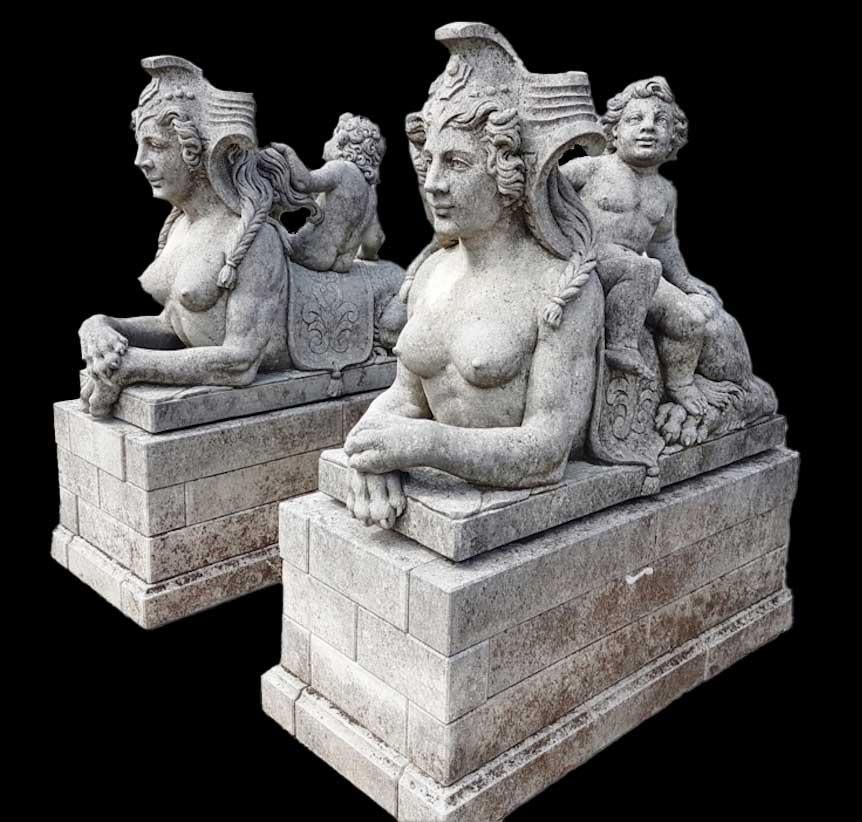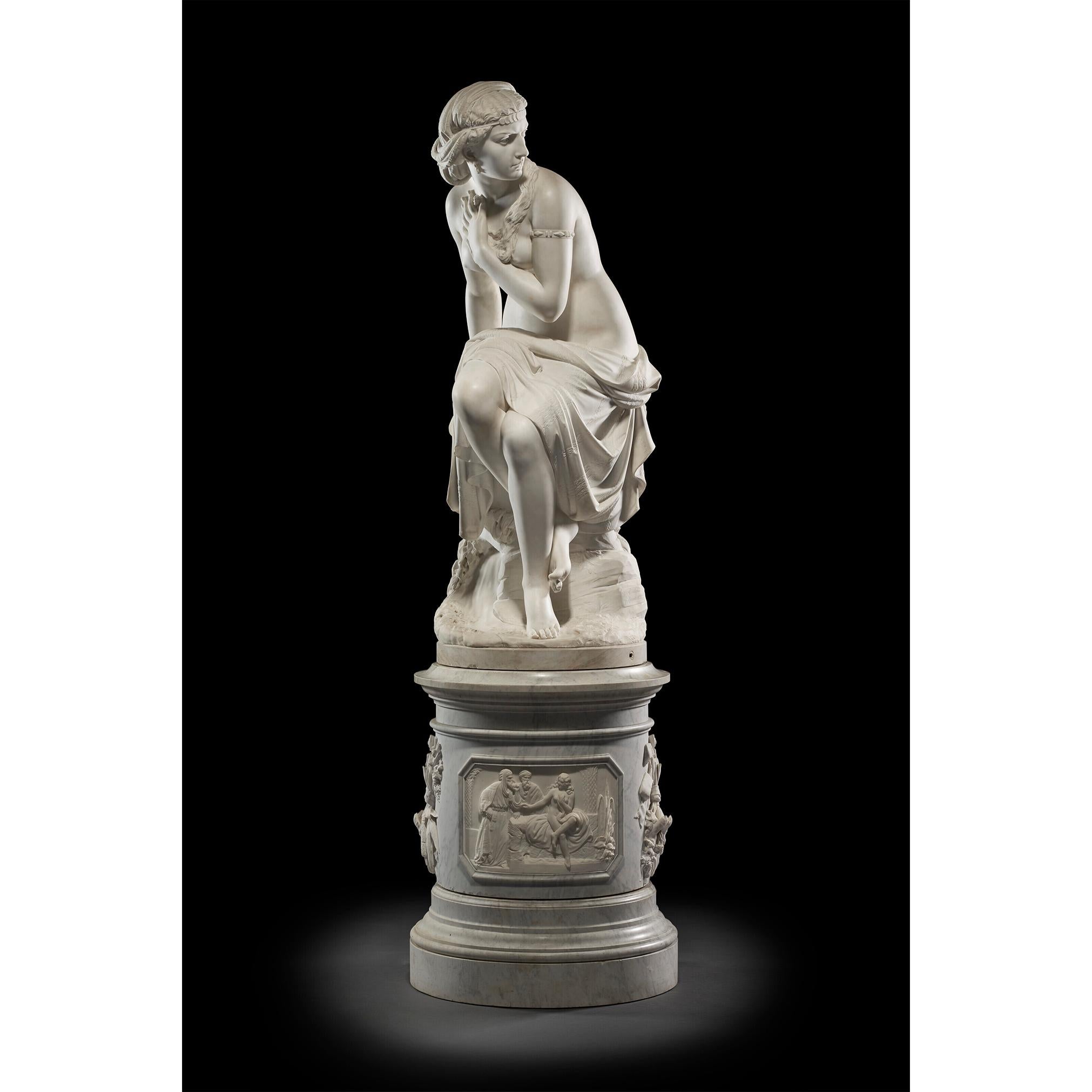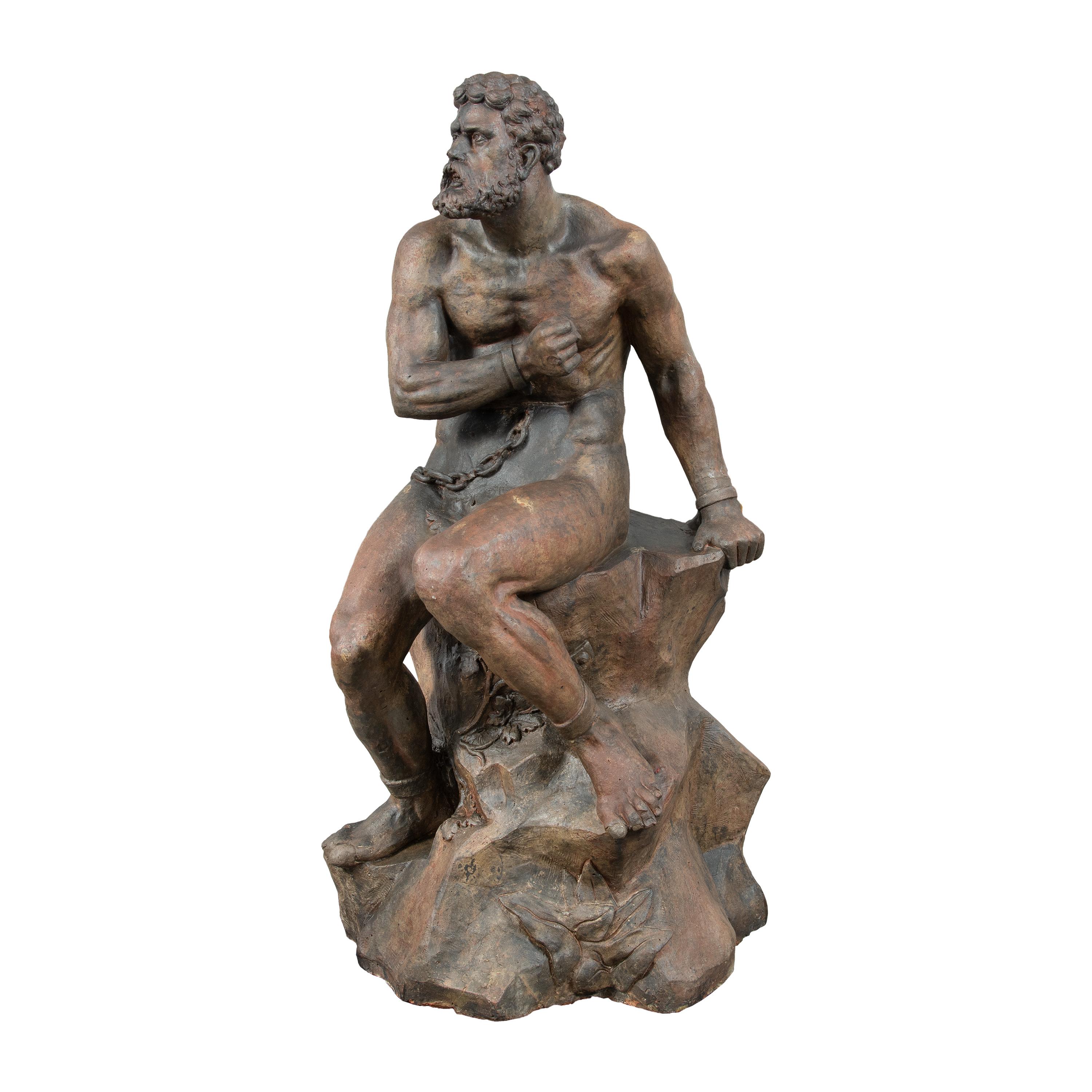Items Similar to A late 17th Italian carved limewood figure of Mermaid, circle of Filippo Parodi
Want more images or videos?
Request additional images or videos from the seller
1 of 18
A late 17th Italian carved limewood figure of Mermaid, circle of Filippo Parodi
About the Item
A late 17th c. Italian carved figure of Mermaid,
Circle of Filippo Parodi (Genoa, 1630 – July 22, 1702)
Dimensions: h. 29.13 in, w. 30.31 in, p. 18.9 in (at the base)
Magnificent Italian Baroque sculpture depicting a mermaid seated on the rock.
All the virtuosity of the sculptor unfolds in this carved group. The fantastic creature is featured seated, the upper part of the body darting forward, the head looking upwards. Sophisticated hairstyle with rows of pearls intertwined in her hair, her loose locks fly in the wind and bring movement to the whole sculpture.
The wide-open eyes with hollowed-out pupils make it possible to follow the mermaid's gaze, towards the sky. The half-open mouth further magnifies this bewitching and seductive attitude.
Its long double tail ending in fins wraps on either side of a rocky mound strewn with objects evoking the underwater world: seashells and shells, branches of coral.
The ornamental richness combined with the great care taken in its execution make it a work in which the splendor of Italian Baroque art unfolds in such characteristic scenic movement.
The composition betrays a strong influence from Filippo Parodi, the leader of Genoese Baroque sculpture, and points to an artist from his circle.
Our sculpture was probably part of a decorative monumental palace.
The iconographic theme evoking the marine world finds its application in the numerous fountains and artificial grottos, designed in Italian palaces at the turn of the 17th and 18th centuries.
Giacomo Filippo Parodi (Genoa 1630 – July 22, 1702) was an Italian Baroque sculptor of the Genoese school, who introduced Bernini's aesthetic to Genoa.
In his youth fathers a first apprenticeship with a carpenter, he went to Rome where he became a pupil of Bernini.
He had the opportunity to admire in person the works and style of the French sculptor Pierre Puget, present in Genoa from 1661 to 1668, and to be singularly influenced by him. Thus, and despite an already advanced age, Filippo Parodi gradually moved away from wood carving to work in marble. He therefore established himself as the main sculptor of Baroque Genoa after the departure of the French artist.
He produced many works for the noble families of Genoa, including the statue of Vergine con Angeli in the Church of San Luca. He also hires out his services in Venice and Padua.
There are among his students quite good sculptors including his son-in-law Giacomo Antonio Ponsonelli, Andrea Brustolon, Francesco Biggi, Domenico Garibaldo, Bernardo Schiaffino and especially Angelo de Rossi, who in some of his works manages to equal the master.
His son Domenico (1668-1740), apprentice of Sebastiano Bombelli then of Carlo Maratta and Paolo Gerolamo Piola, was an important painter. He inherited his father's workshop, at that time the largest in Genoa, and developed it with the help of Biggi.
- Dimensions:Height: 29.13 in (74 cm)Width: 30.31 in (76.99 cm)Depth: 18.9 in (48.01 cm)
- Medium:
- Movement & Style:
- Circle Of:Filippo Parodi (1630 - 1702, Italian)
- Period:Late 17th Century
- Condition:Some scattered cracks, chips consistent with age, all visible on the images.
- Gallery Location:PARIS, FR
- Reference Number:1stDibs: LU2433212502812
About the Seller
No Reviews Yet
Vetted Seller
These experienced sellers undergo a comprehensive evaluation by our team of in-house experts.
1stDibs seller since 2023
- ShippingRetrieving quote...Ships From: PARIS, France
- Return PolicyA return for this item may be initiated within 3 days of delivery.
More From This SellerView All
- Virgin of the Annunciation, Burgundy, early 15th centuryLocated in PARIS, FRVirgin of the Annunciation Burgundy, cercle of Claus de Werve (Haarlem? - Dijon, 1439) Early 15th century Walnut carved in the round Hight: 60 cm The Virgin Mary stands, her right ...Category
15th Century and Earlier Medieval Figurative Sculptures
MaterialsWalnut
- A 16th century Renaissance North Italian marble heads of two puttisLocated in PARIS, FRLovely pair of heads of small cherubs carved in white Carrara marble. The chubby faces adorned with admirable hair with abundant tight and deep curls with a quiff on the forehead. Th...Category
16th Century Renaissance Figurative Sculptures
MaterialsMarble
- Virgin with child, workshop of Pieter Coecke Van Aelst, 16th c. Flemish schoolLocated in PARIS, FRVirgin and Child Workshop of Pieter Coecke Van Aelst (Aelst, 1502- Brussels, 1550) 16th century Oil on oak panel Dimensions: panel: h. 71.5cm, W. 48.5 cm (28.15 in x 19.09 in) Later ...Category
16th Century Old Masters Figurative Paintings
MaterialsOak, Oil
- Ascension day in Venice by Louis de Caullery (1582-1621) 17th c. Flemish schoolLocated in PARIS, FRAscension Day in Venice 17th century Antwerp School Louis de Caullery (1582-1621) Oil on oak panel Dimensions: h. 12.8 in, w. 23.03 in (h. 32,5 cm, w. 58,5 c...Category
Early 17th Century Old Masters Landscape Paintings
MaterialsOil, Oak
- Landscape with figures, workshop of Paul Bril, Italian school 17th CenturyBy Paul BrilLocated in PARIS, FRIdyllic landscape with myhological story of Cephalus and Procris Early 17th century Italian school Workshop Of Paul Bril (Antwerp, 1554 - Roma, 1626) Oil on poplar panel: H. 28 cm (1...Category
Early 17th Century Old Masters Landscape Paintings
MaterialsOil, Poplar
- Rest on the Flight into Egypt - Attributed to Pieter Van Avont - 17th c. FlemishBy Pieter van AvontLocated in PARIS, FRRest during the Flight into Egypt - The Virgin and Child with St. John the Baptist and the angels in a Landscape. Attributed to Pieter Van Avont (1600-1652) 17th century Antwerp School, circa 1630 Oil on oak panel, Dimensions: h. 38 cm, w. 50 cm (14.96 in x 19.68 in) Flemish style frame in ebonized and moulded wood Framed: h. 56 cm, w. 68.5 cm (22.04 in. x 26.97 in.) In the heart of a lush wooded landscape, the Virgin with Jesus rests in a green clearing accompanied by Saint John the Baptist and the cherubs. Seated to the left of the composition, the Virgin Mary holds the Child on her lap; the little Saint John the Baptist wearing the camel-skin tunic (his attribute) stands before Jesus to exchange a few caresses. On the right, the couple of cherubs are playing with the lamb of Saint John the Baptist, bringing a jovial character to the scene. A pair of gardening putti on the left pick flowers to bring bouquets to the Virgin and Jesus. Spring flowers such as tulips, daffodils and anemones that grow abundantly around them and enrich the composition with their shimmering colors. A lush rose bush blooms to the left of the figures offering delicate roses. (The rose is the flower associated with the Virgin Mary, who is the "mystical rose," the one that does not bear the "thorn of sin") At the feet of the Virgin are bunches of grapes (symbol of the future passion of Christ) as well as apples (symbol of the original fall of Man but also of the Redemption in Christ) In the foreground we find a wicker basket filled in profusion with beautiful flowers and guinea pigs nibbling on the blades of grass. In a cleverly arranged disorder, these elements of the still life with their strong symbolic power accentuate the religious theme, but are also an opportunity for the artist to demonstrate his know-how in the still life genre that is gaining momentum in Antwerp. The landscape behind the figures consists of a large tree with a twisted trunk and a luminous opening to the horizon placed on the right. We see Saint Joseph arriving with a donkey, a small reminder from the artist that the composition is associated with the episode of Rest during the flight into Egypt. The calm expanse of this bucolic forest opening onto the luminous distance, with its profusion of symbolic flowers and fruits, is particularly suited to this sacred scene. The theme of Jesus' sacrifice and his tragic fate is mitigated by cherubs who play with innocence and carelessness in the face of the fragility of life symbolized by cut flowers. The great mastery of the painter is manifested by the finesse of the drawing enhanced by the delicacy in the application of the brushstrokes bringing a multitude of details. The richness of the whole is exacerbated thanks to the choice of colours, this varied palette is an undeniable asset of our work. The virtuosity of our artist lies in his versatility, as much concerned with the success of the landscape and flowers as with the modelling of his figures. The cherubs with their naked bodies are gracefully illuminated by warm colours with subtle shadows, while the still life is rendered with astonishing realism, both in the precision of the drawing and in the countless shades of the flowers. There are several compositions similar to ours, of which below are the closest versions: • Sale, Jean-Claude Anaf et Associés, Lyon, 08/02/1998, attributed to Pieter Van Avont, oil on panel, h. 48 cm, l. 71 cm (recorded on RKD n° 31451). Comment: identical composition, only St Joseph with the donkey is different) • Christie's New York sale, 29/01/1998, Pieter Van Avont, oil on copper, h. 23.8 cm, w. 24.8 cm • Dorotheum sale, Vienna, 25/04/2017, Pieter Van Avont and Jan Breughel II, oil on copper, h .26 cm, w. 39 cm • Hermitage Museum, Saint Petersburg, Russia, Pieter Van Avont, oil on panel, h. 50.5 cm, w. 71.7 cm Peter van Avont, Flemish painter (Mechelen, 1600 - Antwerp. 1652) Born in Mechelen, he is mentioned in 1620 as a member of the painters' guild of his hometown. He left in 1 622 for Antwerp, where he was also a member of the guild. He collaborated with many painters, including Jan Brueguel the Younger, David Vinckboons, Lucas van Uden...Category
17th Century Old Masters Landscape Paintings
MaterialsOak, Oil
You May Also Like
- Tuscan Baroque Nude Putto Candle Holder 17-18 century gilded woodLocated in Florence, ITOne flame candle holder putto made of gilded wood. Those kind of objects were present in churches or noble villas, specially during the Baroque times. The base is not coeval.Category
17th Century Baroque Nude Sculptures
MaterialsGold
- Pair of Exceptional Italian Sphinx Limestone StatuesLocated in Rome, ITDesigned as entrance guardians, this pair of mythical lady sphinx statuary display the head and chest of a neoclassical woman and the body of a recu...Category
2010s Baroque Figurative Sculptures
MaterialsLimestone
- The Rape of Sabine Iconic Bronze Sculpture 1930Located in Rome, ITFine Group of Sculptures in Bronze after Jean de Boulogne (Giambologna) The torturously twisting Rape of the Sabine Women is one of the finest and most technically difficult sculpt...Category
1920s Mannerist Figurative Sculptures
MaterialsBronze
- Susanna al bagno Italian Marble Statue by Lombardi with relief sculpture BaseBy Giovan Domenico Lombardi OminoLocated in New York, NYGIOVANNI BATTISTA LOMBARDI (ITALIAN, 1822-1880) A fine marble statue titled Susanna al Bagno sitting on a revolving pedestal carved in relief with...Category
Mid-19th Century Baroque Nude Sculptures
MaterialsMarble
- Baroque master sculptor - 18th century terracotta sculpture - Prometheus figureLocated in Varmo, ITTerracotta sculpture - Prometheus - Italy, 18th century. 48 x 50 cm x h 94 cm. Entirely in terracotta. - All shipments are free and professionally packed. - This item is sold wit...Category
Early 18th Century Baroque Figurative Sculptures
MaterialsTerracotta
- Pair of Exceptional Italian Sphinx Limestone StatuesLocated in Rome, ITDesigned as entrance guardians, this pair of mythical lady sphinx statuary display the head and chest of a neoclassical woman and the body of a recumbent lion on a rectangular stone ...Category
2010s Baroque Figurative Sculptures
MaterialsLimestone
Recently Viewed
View AllMore Ways To Browse
Mermaid Sculpture Fountain
Andrea Brustolon
18th C Wood Carved Figure
Seashell Sculpture Coral
Japanese Bronze One Of Four Ryusen
Mexican Redware
Sahara Novotny
Vincent Magni
Vinh D
Weidlich Brothers
Wutthichai Chamchoi
Yabe Hirosuke
Lalanne Mouton
Virgen Caridad
18 Th Century Female Portraits
Antinous Coin
Armani Porcelain
Balloon Miguel




